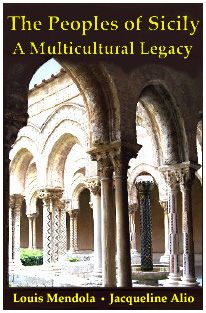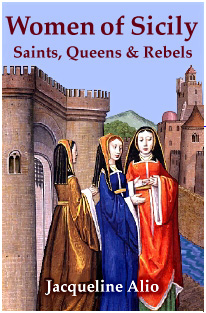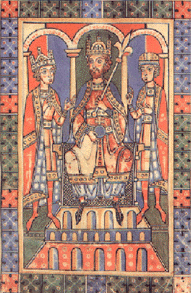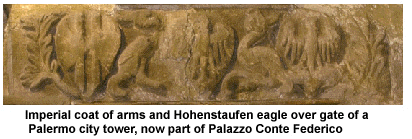Sicilian Peoples: The Swabians - Best of Sicily Magazine (original) (raw)
 The Peoples of Sicily: A Multicultural Legacy. Full of Greeks, Arabs, Normans, Germans and Jews, the most significant general history of Sicily ever published is about much more than an island in the sun. Can the eclectic medieval experience of the world's most conquered island be a lesson for our times? Find out as you meet the peoples! (368 pages on acid-free paper, ebook available) Read more.
The Peoples of Sicily: A Multicultural Legacy. Full of Greeks, Arabs, Normans, Germans and Jews, the most significant general history of Sicily ever published is about much more than an island in the sun. Can the eclectic medieval experience of the world's most conquered island be a lesson for our times? Find out as you meet the peoples! (368 pages on acid-free paper, ebook available) Read more.
 Women of Sicily: Saints, Queens & Rebels. Meet a timeless sisterhood of pious Roman maidens, steadfast Sicilian queens, and a Jewish mother who faced the horrors of the Inquisition. Find an island's feminine soul in the first book about Sicily's historical women written in English by a Sicilian woman in Sicily. (224 pages on acid-free paper, ebook available) Read more.
Women of Sicily: Saints, Queens & Rebels. Meet a timeless sisterhood of pious Roman maidens, steadfast Sicilian queens, and a Jewish mother who faced the horrors of the Inquisition. Find an island's feminine soul in the first book about Sicily's historical women written in English by a Sicilian woman in Sicily. (224 pages on acid-free paper, ebook available) Read more.
| Some Terms |
|---|
| Angevins - People and dynasty of Anjou in France. Arabs - Semitic, Arabic-speaking peoples of Arabia and other regions. Also Moors and Saracens. Byzantine - Pertaining to Byzantium or its culture. Relating to medieval successor of the Eastern Roman Empire until 15th century. Byzantium - Constantinople (see below). Christianity - Religion based on the teachings of Jesus Christ (c. 4 BC- c. AD 28) as Son of God (and Messiah), revealed particularly through the Bible, including the New Testament. Constantinople - Later name for Byzantium, city founded by Greeks on the Bosporus strait. Islam - Religion founded by Muhammad (570-632) in Arabia as Prophet of Allah (God), whose message is revealed in the Koran. Islam is Arabic for "surrender" or "submission." Jews - People whose religion is rooted in Judaism (see below). Often, those whose ethnic origins are Hebrew and Jewish. Judaism - Monotheistic religion of the Hebrews, based on the Biblical Old Testament and Talmud. From "Judea," a kingdom and later a Roman province. Latin - Language of Rome, also Italic culture of Rome, the Western Roman Empire and the Roman Catholic Church. Lombards - People of Lombardy in northern Italy, by 1200 descended from both Germanic Longobards and native Romans. Middle Ages - Period dated from fall of Rome (AD 476) to Goths until fall of Constantinople to Turks (1453), or from 500 to 1500. Moors - Also Saracens. Arab peoples, usually Muslim, who conquered medieval Sicily, Spain and northwestern Africa. Normans - People of Frankish and Nordic (Viking) origin in Normandy who conquered parts of Italy and Britain in 11th century. Orthodoxy - Relating to the original Christian Church and its traditional teachings maintained in the East, as opposed to the Roman Catholic Church of the West. Roman Catholic - Church of Rome, particularly following the Schism of 1054. Swabians - People of Swabia region in southern Germany. |

 If the Normans brought Sicily back into the European orbit following centuries of Byzantineand Arab rule, the Swabians made it one of the most important regions of Europe. Swabia is a region of southwestern Germany which in the twelfth century included part of Bavaria and eastern Switzerland. Swabia takes its name from a Germanic people, the Suabi, and borders the region once ruled by the Alemanni, another Germanic tribe.
If the Normans brought Sicily back into the European orbit following centuries of Byzantineand Arab rule, the Swabians made it one of the most important regions of Europe. Swabia is a region of southwestern Germany which in the twelfth century included part of Bavaria and eastern Switzerland. Swabia takes its name from a Germanic people, the Suabi, and borders the region once ruled by the Alemanni, another Germanic tribe.
The Swabian Staufer (Hohenstaufen) family emerged as a powerful dynasty before 1100. Their name comes from Stauf Castle, built near Göppingen in the Jura Mountains by Count Frederick (died 1105). Their early history was not too different from those of other central European nobility emerging in the high medieval era, but the Dukes of Swabia became Kings of Germany during the rule of the distinguished Frederick I "Barbarossa" ("Redbeard") in 1152. From 1138 until 1254, the Hohenstaufen ruled as emperors of the loose feudal confederation known as the Holy Roman Empire. The sovereign state of Swabia itself was dissolved after 1268, its lands seized by lesser families, but in the 1190s it was the focal point of a kind of vaguely defined German unity.
It was neither holy, nor Roman, nor an empire, but the confederation founded by Charlemagne was Europe's most powerful monarchy. In 1186, Constance Hauteville, the youngest child of King Roger II of Sicily, was betrothed to Henry VI, second son of Frederick Barbarossa. This was seen as a way of sealing the Normans' rapport with the dynasty which controlled not only the Alpine regions but most of Italy north of Bologna.
By virtue of his consort, Henry claimed the Sicilian crown in 1194 following the brief and ineffectual reign of Tancred, Constance's illegitimate nephew through her eldest brother, Roger of Apulia (died 1149).
When Henry VI was crowned in Palermo, he found himself in control of the island of Sicily and all of mainland Italy except for a central region (the Papal State) controlled by the Papacy, a situation the Pope and other sovereigns  found disturbing - indeed overtly threatening.
found disturbing - indeed overtly threatening.
The Emperor's power was not absolute. Eventually, a rivalry between factions developed, with the Guelphs (Welfs) opposing the Ghibellines(Hohenstaufen supporters who took their Italianized name from the Staufenfortress of Waiblingen). In time, the Guelphs supported the Pope (and the Angevins) against the Swabians. This undercurrent determined Imperial politics in some parts of Italy.
His wife may have been a Norman princess, but the Sicilians did not welcome Henry and his suite of German knights and retainers very warmly. The new king installed several commanderies of recently-founded Teutonic Order of knights in Sicily, appropriating for them Palermo's Magione Church and constructing for them the Church of Saint Mary of the Germans in Messina. Though only a few walls and arches remain, Saint Mary is one of the few examples of more-or-less pure Gothic architecture in Sicily. Constance gave birth to**Frederick II** who, like his grandfather Roger II, was one of Europe's most enlightened rulers.
Henry VI died in 1197. While his widow raised their young son in Sicily, many of the unruly Imperial vassals reneged on their feudal obligations. Upon reaching the age of majority, Frederick sought to remedy this. His realm included regions from Saxony to Palestine, effectively ruled from Palermo, though he traveled almost continually. The kingdoms of Sicily and Jerusalem were not part of the Holy Roman Empire; strictly speaking, they were separate realms which just happened to be ruled by the same monarch. Furthermore, the kingship of Germany was one thing, the emperorship something more.
Some historians regard the Swabian (or Suabian) period as a continuation of the Norman rule of Sicily. However, Sicily changed greatly under the Swabians. Despite Frederick's quarrels with the Papacy, leading to excommunication, the church in Sicily became almost completely Latinized during his long reign. By 1250, there were no Byzantine parishes in Sicily --only a fewOrthodox monasteries remained. Following a series of revolts, a few thousand Muslim Arabs were "exiled" to Lucera in Apulia, while thousands more converted to Catholicism. By 1250, mosques were a rare sight. In 1200, Sicily was a multicultural kingdom; by the end of the Swabian era a half-century later it was an essentially "European" one. This was true of customs, language (Sicilian) and law. All bore the mark of Arab and Byzantine influences but were now almost "Italian."
It was during the Swabian period that the Sicilian language later recognized by Dante and then Boccaccio truly evolved. The sonnet is thought to have been born at the court of Frederick II.
Architecture gradually lost its Byzantine and Arab features. An Italianate "Gothicized" Romanesque prevailed. Though present in some Norman-era castles and churches, most of the arched two-light windows visible around Sicily date from the Swabian period or the century following it. Frederick built a number of castles, such as the fortress at Catania.
The people themselves did not immediately change. Sicily was still the heart of an important realm, even if absentee administration became commonplace. In the countryside, feudalism flowered.
The term "Swabian" is misleading. Many of the arrivals were German or Lombard but not Swabian. Lombard garrisons loyal to Frederick were installed in several towns, the native "Norman" nobles regarded as too fickle. Initially, Frederick also had Saracen (Arab) troops. Constance of Aragon, Frederick's wife, brought an Iberian influence to the Sicilian court.
While Frederick was a brilliant man, it appears that he was not generally liked by the Sicilians. Indeed, Swabian rule generally appears not to have been appreciated either by the nobility or the other classes. Despite this, a stronger national identity was being forged among the Sicilians, continuing what had begun in Norman times. At Frederick's death, in 1250, Pope Innocent IV tightened his grip on the island. The strong papal influence, which eventually led to Angevin rule and consequently, in 1282, the War of the Vespers, was not at all progressive. For comparison, we may consider that England's Magna Carta, issued in 1215, set forth royal and baronial rights and duties for centuries to come. In Sicily, despite numerous "parliaments" and declarations over the years, nothing comparable ever emerged, even though there were numerous laws, such as the remarkable Assizes of Ariano of Roger II.
Following the death of Frederick in 1250, three of his descendants claimed the throne in succession, but the antipathy of the Guelphs and the Papacy had not abated. Frederick's son Conrad IV died in 1254. An illegitimate son, Manfred, was killed at the Battle of Benevento in 1266 when his army was defeated by an Angevin force commanded by Charles of Anjou, the papal choice to succeed as king of Sicily. Frederick's grandson, Conradin (Conrad's son), was executed in 1268 at the age of sixteen. With the end of the Hohenstaufen dynasty, southern Italy passed into the hands of the House of Anjou, which ruled Sicily from Naples until the House of Aragon, and the Sicilians themselves, challenged French authority in 1282.
1254. An illegitimate son, Manfred, was killed at the Battle of Benevento in 1266 when his army was defeated by an Angevin force commanded by Charles of Anjou, the papal choice to succeed as king of Sicily. Frederick's grandson, Conradin (Conrad's son), was executed in 1268 at the age of sixteen. With the end of the Hohenstaufen dynasty, southern Italy passed into the hands of the House of Anjou, which ruled Sicily from Naples until the House of Aragon, and the Sicilians themselves, challenged French authority in 1282.
The end of Hohenstaufen rule was a turning point in history because henceforth Sicily would only rarely be ruled by resident kings. Instead, it was usually administered by viceroys. Moreover, the island nation lost her importance in world affairs. There is also a cultural factor to be considered. Had the thirteenth-century popes (and their Guelphic allies) not had their way, Italy might have evolved into a state with a society in some ways more Germanic than Latin.
We do not know how many Germans and Lombards remained in Sicily following the Swabian period. Those who received feudal lands certainly stayed, and in several towns certain surnames - and even some commonly used words - bear the mark of Germanic influences. The Teutonic Knights maintained several Sicilian commanderies well into the 1300s, undisturbed by subsequent dynasties.
About the Authors: Luigi Mendola is the History Editor of Best of Sicily and author of several books. Palermo native Vincenzo Salerno, who contributed to this article, has written biographies of several famous Sicilians, including Frederick II and Giuseppe di Lampedusa.